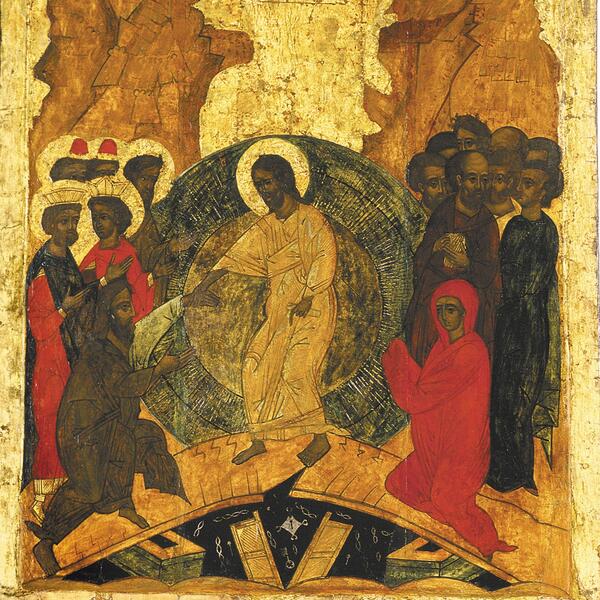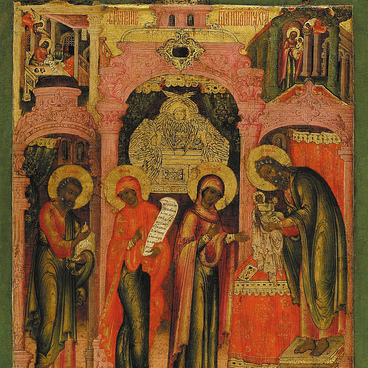The Harrowing of Hell is an event that is related to the Resurrection of Christ but is less frequently mentioned in religious texts. The Gospel of Matthew includes only the Savior’s prophecy that he would “be three days and three nights in the heart of the earth” just as Jonas was “in the whale’s belly”. This is reiterated in the Easter hymn by John of Damascus, “Thou didst descend into the lowest parts of the earth, o Christ; and, having broken the eternal bars which held the prisoners, Thou didst on the third day, as Jonah from the whale, rise again from the tomb.”
The Harrowing of Hell is described in detail in the apocryphal Gospel of Nicodemus and in church legends. After Jesus sacrificed himself on the cross, Satan tried to hide from him in the depths of Hell. However, even before resurrecting and appearing to the disciples, the Savior descended to the gates of Hell and broke them, releasing the progenitors of the human race Adam and Eve, and the righteous prophets of the pre-Christian world, who had anticipated the arrival of Jesus long before his birth. As the Son of Man, he descended to the very depths where humans could end up and, as the Son of God, he showed the greatest glory and mercy.
The scene’s iconography was formed only by the 11th century. The central figure of the icon is Christ wearing golden yellow clothes and surrounded by a halo of glory — the clothes of the “world to come”. In his left hand, he holds a scroll that symbolizes the sermon of the Resurrection (in another version, the scroll is replaced by the cross as the sign of victory). With his feet, Jesus treads upon the crisscrossed panels of the destroyed gates of Hell. At the bottom of the icon is the dark abyss where the viewer can see an ax, keys, and a latch — the symbols of the destroyed gates of Hell and the suffering of its prisoners. Various versions also depict the defeated prince of evil beaten and tied by the angels. Adam and Eve rise out of destroyed coffins, released from the eternal bonds of death. With his right hand, Jesus leads Adam out into the Light, while Eve waits for her turn humbly, with her hands folded in prayer. Following Adam are righteous kings David and Solomon in crowns, and prophets Daniel and Zacharias in traditional Jewish hats. John the Baptist reaches his hands toward Jesus. Behind Eve’s back is Moses leading the Israelites.
This image has various iconographic versions. Christ may be depicted with his arms up to his sides or carrying the liberated souls. The number of pre-Christian righteous men and women may vary, there may also be angels beating the prince of evil and lighting the darkness of Hell.
This icon is celebrated on Holy Saturday, the day before Easter.
The Harrowing of Hell is described in detail in the apocryphal Gospel of Nicodemus and in church legends. After Jesus sacrificed himself on the cross, Satan tried to hide from him in the depths of Hell. However, even before resurrecting and appearing to the disciples, the Savior descended to the gates of Hell and broke them, releasing the progenitors of the human race Adam and Eve, and the righteous prophets of the pre-Christian world, who had anticipated the arrival of Jesus long before his birth. As the Son of Man, he descended to the very depths where humans could end up and, as the Son of God, he showed the greatest glory and mercy.
The scene’s iconography was formed only by the 11th century. The central figure of the icon is Christ wearing golden yellow clothes and surrounded by a halo of glory — the clothes of the “world to come”. In his left hand, he holds a scroll that symbolizes the sermon of the Resurrection (in another version, the scroll is replaced by the cross as the sign of victory). With his feet, Jesus treads upon the crisscrossed panels of the destroyed gates of Hell. At the bottom of the icon is the dark abyss where the viewer can see an ax, keys, and a latch — the symbols of the destroyed gates of Hell and the suffering of its prisoners. Various versions also depict the defeated prince of evil beaten and tied by the angels. Adam and Eve rise out of destroyed coffins, released from the eternal bonds of death. With his right hand, Jesus leads Adam out into the Light, while Eve waits for her turn humbly, with her hands folded in prayer. Following Adam are righteous kings David and Solomon in crowns, and prophets Daniel and Zacharias in traditional Jewish hats. John the Baptist reaches his hands toward Jesus. Behind Eve’s back is Moses leading the Israelites.
This image has various iconographic versions. Christ may be depicted with his arms up to his sides or carrying the liberated souls. The number of pre-Christian righteous men and women may vary, there may also be angels beating the prince of evil and lighting the darkness of Hell.
This icon is celebrated on Holy Saturday, the day before Easter.



